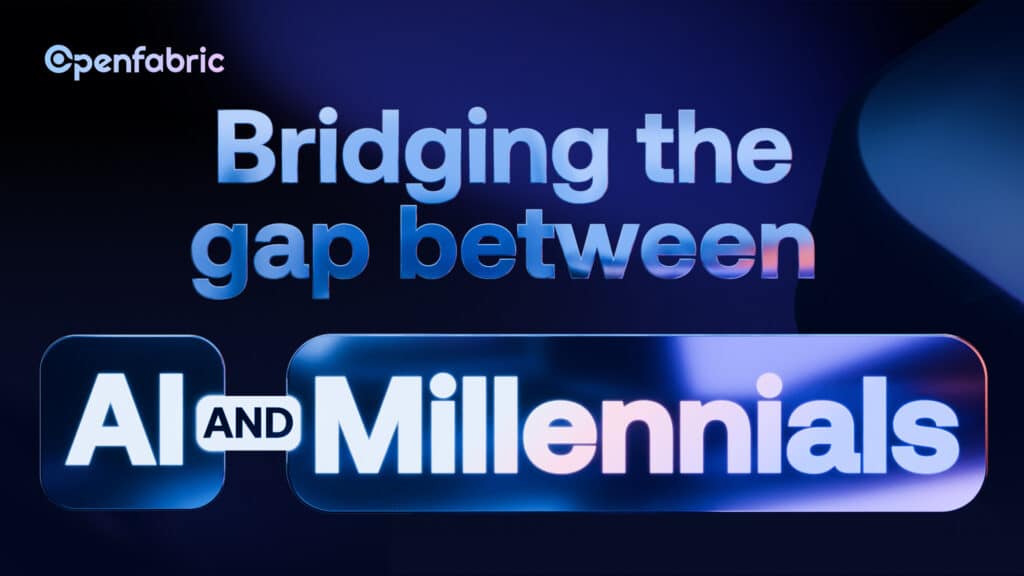
August 16, 2024 7 minutes read
Bridging the gap between AI and Millennials

Technological advancements are so rapid that it is easy to lose track of them. This can clearly be seen in the adoption of AI technology by individuals that were born into rapid technological growth as compared to those that weren’t. Generation Z and Generation X are the major users of technological advancements such as AI, when compared to older generations such as millennials. Thus, there is a gap between AI and millennials.
It is important to note that this gap is not just restricted to millennials alone. However, it grows with generations before such as Generation X (1961 – 1980) and Baby Boomers (1946 – 1960).
There are three reasons why our focus is on Millennials. They are;
- They represent a significant part of the workforce. A study showed that Millennials form about 57% of the workforce and this number will grow in a few years.
- They are more malleable to learning how to use advanced technologies such as AI than earlier generations.
- They are willing to accept and implement these technological advancements in their everyday activities.
Therefore, they are the key to ensuring that advanced technologies such as Artificial Intelligence makes their way into every sector. This is to ensure an enhanced efficiency and productivity in various sectors in the world.
To bridge this generational divide we need some mechanisms in place. In this article, we will explore some of these mechanisms that can be used to bridge the gap between AI and millennials.
Who are Millennials?
It is globally accepted that Millennials are individuals born between 1981 – 1996. They are also referred to as Generation Y.
A large percentage of this group of individuals were raised with early smartphone models and the internet on computers. They saw major advancements in technology and rapidly evolved to them. However, these individuals peaked at a certain age while technological advancements continued thus creating a gap.
A true reflection of this is the preferred choice of social media platform for Millennials and Gen Z. A study made recently, stated that Millennials make up about 50% of Facebook users while a separate study indicates that about 60% of Tiktok users are Gen Zers. This is the same trend with the use of AI.
Challenges and faced by this generation
On the issue of AI and millennials, there have been quite a number of challenges faced. The key is to bridge the gap between them to bring us a step closer to the wide application of artificial intelligence.
Let’s take a look at some of these challenges.
Personal data privacy concerns
The safety and privacy of personal data is of concern in the use of AI applications to not only Millennials but the general population as well. However, it further hinders the use of AI tools and applications by Millennials, thus, widening the generational gap.
Millennials have a great deal of concern when it comes to how their personal data is used. In most cases, they want to have control over how it is used.
Rapid growth of AI
Artificial intelligence has grown rapidly within the last decade. This very rapid growth and evolution has caused a lag in the wide adoption of AI by Millennials.
Gone are the days when Millennials were teens and had the time to get acquainted with evolving technology. These days, they are family people, students or career focused individuals with little or no time to get up to speed with the advanced technologies.
Gradually, they are getting left behind and it is widening the gap more and more.
Myths about artificial intelligence
Millennials while having grown up in a digital evolving landscape can also be affected by some myths about artificial intelligence. Examples of such myths include:
- Myth 1: AI will replace human jobs and creativity.
Reality: AI will support human capabilities, freeing us from routine and unproductive tasks, allowing focus on creative and problem-solving tasks. - Myth 2: AI is sentient and will overthrow humans
Reality: AI is programmed to only perform specific tasks. It lacks the consciousness and self-awareness humans have.
Many of these myths are as a result of fiction and might be aggravated by the realism that AI provides. However, these misconceptions about AI’s capabilities and intentions have led to unnecessary fears which further discourages the adoption of AI.
Compatibility of AI applications on devices
Some AI applications and software are not so compatible with popular devices. Some individuals might not know how to go around this problem and are further discouraged from using these AI applications and tools.
Increasing integration of AI tools
Everywhere on the internet is filled with numerous AI applications for different purposes. This alone can get overwhelming for individuals that are not very familiar with these applications. From searching for appropriate tools for specific tasks to verifying the trustworthiness of these tools, individuals are often tired out. Thus, they lose interest in using these tools.
How can we bridge the gap between AI and Millennials
Since we have identified the problems with the use of AI by Millennials, it is easier for us to consider the factors that must be considered to close this gap.
Here are some of them.
Regulation of personal data security
As we stated earlier, Millennials take their personal data seriously. As such, there must be strict regulations to eliminate misuse or breach of user data.
Through decentralization, data can be encrypted, making it unavailable to other people and giving users control over their data.
Addressing concerns about data privacy, security, and AI decision-making processes will establish trust and confidence.
User-friendly interface
Millennials value simplicity and ease of use. Ensure that AI tools and applications have intuitive interfaces, with clear instructions, and minimal complexity.
Capping it all up, allow for chatbots or self help features to address and query or confusion that may arise while using the AI tool.
Increase compatibility with devices
Many AI tools are only compatible with one type of device. However, making them compatible with various devices increases the versatility of these devices and makes them easier to use even on the go.
Practical applications to real-life scenarios
Millennials appreciate the value of a tool if it solves a real-life problem. Therefore, to encourage an increased use, AI tools must have practical applications to real-life scenarios in different industries and niches. For example, AI assistants have numerous real-life applications and are widely adopted.
Openfabric AI Platform is for Everyone
Openfabric AI has something for everyone. Most importantly, it is a platform that can be used by anyone and has wide applications. It is a flexible and all inclusive platform that puts their users first, providing the best experience possible.
Here are some features of Openfabric AI that will help to close the gap between AI and Millennials.
- User-friendly interface: the platform is easy to use and has interactive features for a more simplified user experience.
- Natural Language Processing (NLP): Whether you want to generate a 3D model or simply browse your document, you just need a simple text prompt. You don’t need any technical language to use any of the tools on the Openfabric AI platform.
- Easy navigation: each click takes you exactly where you need to go without any hassle. It has a smooth flow and is compartmentalized for you to find what you are looking for easily.
- User privacy security: we value your privacy that is why we run a decentralized platform giving you control over your data and allowing you to see how your data is being used.
- Wide range of tools for everyday use: our platform is home to highly recommended tools that can be used in marketing, creativity, finance and so on. These tools are developed by professional AI developers to bring all your creative ideas to life.
Here, the only limitation is your mind!!!
You can find these tools in our AI marketplace. - Compatibility: you can use any of the Openfabric AI tools on your mobile devices and laptops. Furthermore, our tools can be connected to other devices or tools such as printers.
Conclusion
We need the earlier generation to actualise the idea of a fully technological world since they are at the forefront of the global workforce. Technology is not new to Millennials, that is why we must leverage this to prevent the divide between AI and Millennials from getting bigger.
By doing so, we are on our way to a world where life is easier because of automation.
Keep up with the best AI technology on the Openfabric AI WEBSITE.

